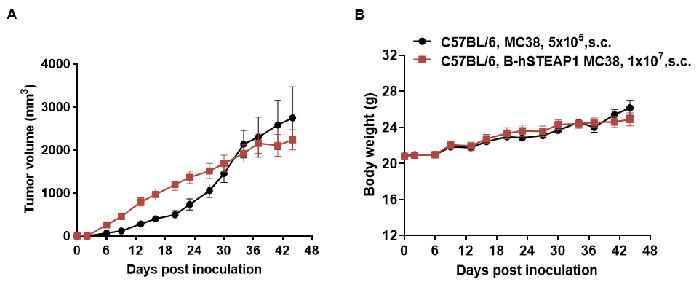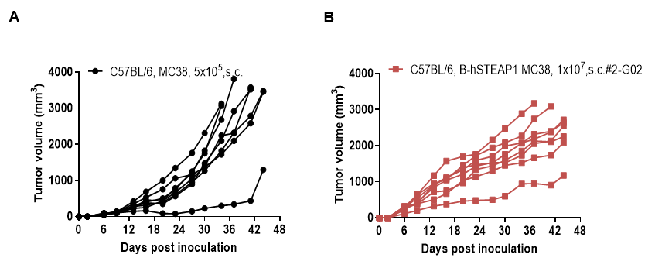B-hSTEAP1 MC38
|
Common name |
B-hSTEAP1 MC38 | Catalog number | 322199 |
| Aliases |
STEAP; PRSS24 |
Disease | Colon carcinoma |
|
Organism |
Mouse |
Strain | C57BL/6 |
| Tissue types | Colon | Tissue | Colon |
Gene targeting strategy for B-hSTEAP1 MC38 cells. The exogenous promoter and human STEAP1 coding sequence was inserted to replace part of murine exon 3. The insertion disrupts the endogenous murine Steap1 gene, resulting in a non-functional transcript.

Subcutaneous homograft tumor growth of B-hSTEAP1 MC38 cells. B-hSTEAP1 MC38 cells (1x107) and wild-type MC38 cells (5x105) were subcutaneously implanted into C57BL/6 mice (female, 11-week-old, n=8). Tumor volume and body weight were measured twice a week. (A) Average tumor volume ± SEM. (B) Body weight (Mean± SEM). Volume was expressed in mm3 using the formula: V=0.5 X long diameter X short diameter2. As shown in panel A, B-hSTEAP1 MC38 cells were able to establish tumors in vivo and can be used for efficacy studies.

B-hSTEAP1 MC38 tumor cells growth of individual mice. B-hSTEAP1 MC38 cells (1x107) and wild-type MC38 cells (5x105) were subcutaneously implanted into C57BL/6 mice (female, 11-week-old, n=8). As shown in panel, B-hSTEAP1 MC38 cells were able to establish tumors in vivo and can be used for efficacy studies.












 京公网安备:
京公网安备: